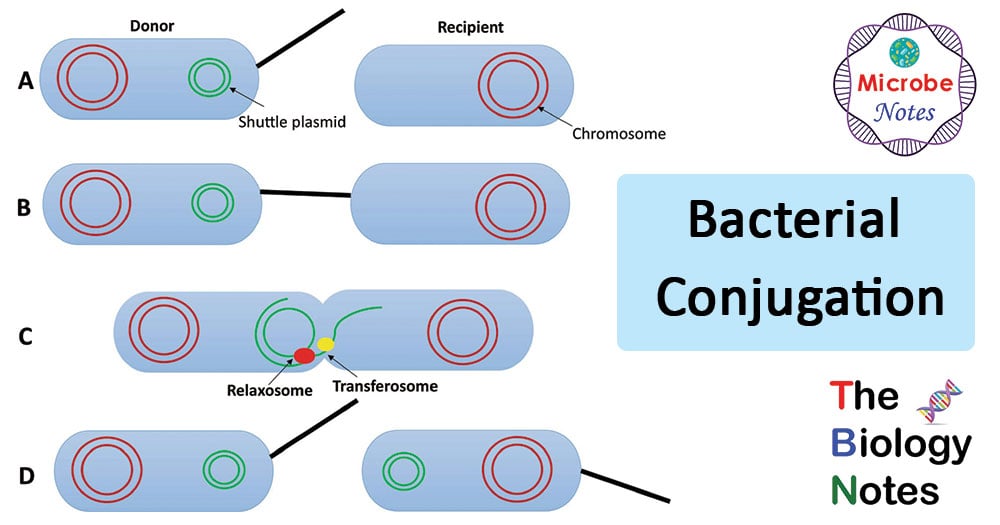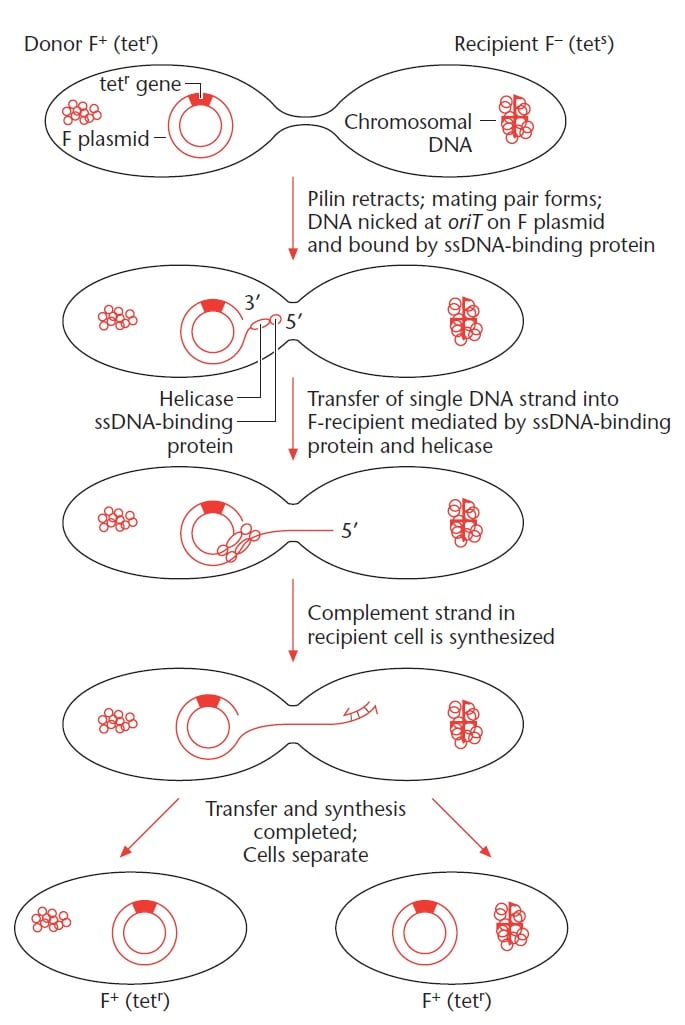Interesting Science Videos
Bacterial Conjugation Definition
- Conjugation is the transfer of a plasmid or other self-transmissible DNA element and sometimes chromosomal DNA from a donor cell to a recipient cell via direct contact usually mediated by a conjugation pilus or sex pilus.
- Recipients of the DNA transferred by conjugation are called transconjugants.
- The process of conjugation can transfer DNA regions of hundreds to thousands of kilobases and has the broadest host range for DNA transfer among the methods for bacterial exchange.
- Conjugation occurs in and between many species of bacteria, including Gram-negative as well as Gram-positive bacteria, and even occurs between bacteria and plants.
- Broad-host-range conjugative plasmids have been used in molecular biology to introduce recombinant genes into bacterial species that are refractory to routine transformation or transduction methods.
- Although numerous examples of conjugative plasmids exist, conjugation involving the F plasmid is the most common.

Figure: Bacterial Conjugation. Image Source: https://doi.org/10.1007/s00253-017-8156-1
Principle of Bacterial Conjugation
- The process of bacterial conjugation is based on the principle that the plasmid or any other genetic material is transferred from the donor cell to the recipient cell through close physical contact.
- Of all the conjugative plasmids, the F (fertility) plasmid of E. coli was the first discovered and is one of the best-studied.
- The F plasmid is present in one or two copies per cell and is very large (about 100 kilobases). E. coli harboring the F plasmid are referred to as donor (F+ or male) cells and E. coli lacking the F plasmid are referred to as recipient (F– or female) cells. Only donor cells are capable of transferring the F plasmid to recipient cells.
- For transfer of the F plasmid from donor to recipient, intimate contact between cells, resulting in mating-pair formation, is required.
- The transfer of genetic material is then brought by membrane fusion of the two cells by the action of different enzymes.
- Following the membrane fusion, the replication of donor DNA occurs and is transferred into the recipient cell.
Steps/Process of Bacterial Conjugation

Figure: Steps/Process of Bacterial Conjugation. Image Source: https://doi.org/10.1038/npg.els.0001416
The following process occurs during the transfer of F plasmid in E. coli by conjugation:
- The F plasmid contains tra locus, which includes the pilin This gene, along with some regulatory proteins results in the formation of pilli on the F+ cell surface.
- The proteins present in the pilli attach themselves on the F– cell surface. The pilli are responsible for making contact between the cells, but the transfer of plasmid doesn’t occur through the pilli.
- The traD enzyme, located at the base of the pilus, initiates membrane fusion.
- Once the conjugation is initiated, enzyme relaxase creates a nick in the conjugative plasmid at the oriT
- The nicked strand (called the T strand) then unwinds and is transferred to the recipient cell in the 5’-3’ direction.
- The complementary strand is synthesized in both cells; thus, both the donor and recipient are F+.
- In certain F+ bacterial cells, the F element infrequently (about once in every 10,000 F+ cells) becomes associated with the main bacterial chromosome in such a way that a copy of the chromosome instead is transferred through the conjugation tube from donor to recipient cell.
- In the insertion process, the circular F element breaks at a particular point and becomes a linear segment of the bacterial chromosome.
- An F+ cell that carries such an integrated F element is known as an Hfr cell (Hfr stands for the high frequency of recombination).
- The integrated F element of Hfr cells is ordinarily replicated passively along with the bacterial chromosome and in this way is transmitted from one Hfr generation to the next.
Other conjugative elements
- Broad-host-range conjugative plasmids, such as RK2, can be transferred among many bacterial genera and even from bacteria to yeast.
- In addition, there exist plasmids that harbor oriT, but that are not self-transmissible because they lack some or all of the necessary tra
- However, if the tra genes are provided on a separate replicon, these plasmids can be mobilized for transfer. Such plasmids are called mobilizable plasmids.
Examples of bacterial conjugation
- Agrobacterium tumefaciens causes crown gall tumor in plants by transferring the T DNA element, a part of the Ti (tumor-inducing) plasmid present in this bacterium, into a plant cell where the T element becomes incorporated into the plant cell’s genome.
- Conjugative plasmids encoding antimicrobial resistance genes are called R plasmids which are transferred through Shigella spp that might result in a widespread outbreak of antibiotic-resistant Shigella-mediated dysentery.
References
- Verma PS and Agarwal VK (3005). Cell Biology, Genetics, Molecular Biology, Evolution and Ecology. Multicolored Edition.
- McGee, David & Coker, Christopher & Harro, Janette & Mobley, Harry. (2001). Bacterial Genetic Exchange. Doi: 10.1038/npg.els.0001416.
- Griffiths AJF, Miller JH, Suzuki DT, et al. An Introduction to Genetic Analysis. 7th edition. New York: W. H. Freeman; 2000. Bacterial conjugation.Available from: https://www.ncbi.nlm.nih.gov/books/NBK21942/
- Adelberg EA and Pittard J (1965). Chromosome transfer in bacterial conjugation. Bacteriological Reviews.
- Deng, Y., Zhang, X. & Zhang, X. Recent advances in genetic modification systems for Actinobacteria. Appl Microbiol Biotechnol 101, 2217–2226 (2017). https://doi.org/10.1007/s00253-017-8156-1 (Figure)
Sources
- 22% – https://www.researchgate.net/publication/230247422_Bacterial_Genetic_Exchange
- 11% – http://docshare.tips/bacterial-genetic-exchangepdf_58dd2729ee3435da3e991780.html
- 3% – http://www.biologydiscussion.com/cell/prokaryotes/plasmids-meaning-classes-and-uses-genetics/36414
- 1% – https://www.sciencedirect.com/topics/biochemistry-genetics-and-molecular-biology/bacterial-conjugation
- 1% – https://www.quora.com/What-is-the-result-of-conjugation-of-an-Hfr-cell-with-a-F+-cell
- 1% – https://www.ncbi.nlm.nih.gov/pmc/articles/PMC4006022/
- 1% – https://www.britannica.com/science/conjugation-sexual-process
- 1% – https://quizlet.com/84234537/microbiology-chapter-8-flash-cards/
- 1% – https://quizlet.com/274531308/mcb2004-ch-8-flash-cards/
- 1% – http://www8.umoncton.ca/umcm-filion_martin/Solutions/iga_10e_sm_chapter_05.pdf
- 1% – http://www.biologydiscussion.com/cell/prokaryotes/f-plasmid-organisation-mechanism-and-integration-chromosomes/36435
- <1% – https://mbio.asm.org/content/9/1/e02011-17

Help full